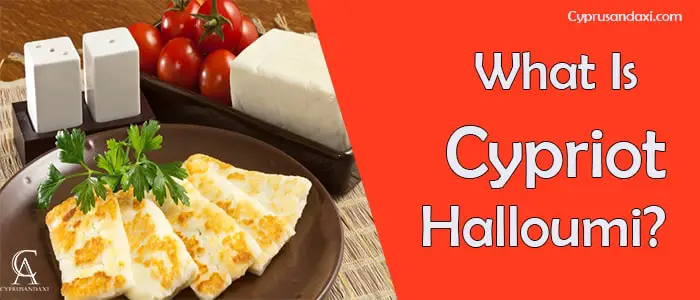Cypriot Halloumi is a traditional Cypriot cheese that is semi-hard in state and comprises a mixture of Goat’s and Sheep’s milk. Sometimes Cow’s milk is also used in making Halloumi.
Halloumi is white in color, and it has a high melting point. Because of that, it doesn’t easily melt in high temperatures.
Halloumi is considered as one of the world’s most grillable cheese by the Culinary community and rooters.
Interesting, isn’t it?
Today in this article, we will learn almost everything about Halloumi that there is to know.
Set your device’s screen to the reading mode and enjoy the article.
History of Halloumi

The English word Halloumi is derived from the Greek word Khalloúmi (χαλλούμι).
The Greek name Khalloumi is also borrowed from multiple other languages.
Greek Cypriots call it Khalloumi, whereas Turkish Cypriots call it Hellim.
Halloumi’s origin is dated back to the Eastern Roman Empire in somewhere between 395 AD to 1191 AD.
Cypriot villagers knew that Halloumi is a wealthy source of Protein. As you can use it in all the seasons, Cypriot farmers used to make big batches of Halloumi together and eat it for the whole year.
The production of Halloumi and the recipes varied from village to village.
Initially, Cypriots used to make Halloumi from Sheep’s milk and Goat’s milk. During the 20th century, when Britishers brought Cows to Cyprus, people started creating Halloumi with a mixture of cow’s, goat’s, and sheep’s milk.
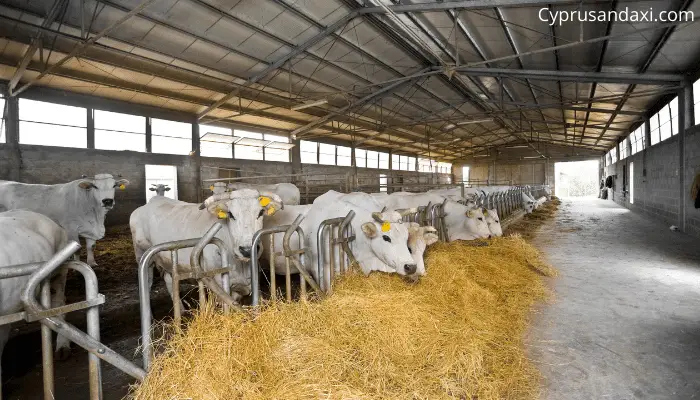
Over the years, halloumi’s need became very high due to globalization, and dairy farmers could not meet the demand.
Goats and Sheep are not able to produce a lot of milk during the hot seasons. Hence, Cow’s milk began to be added to the blend as there was more of it available.
What does Halloumi look like?
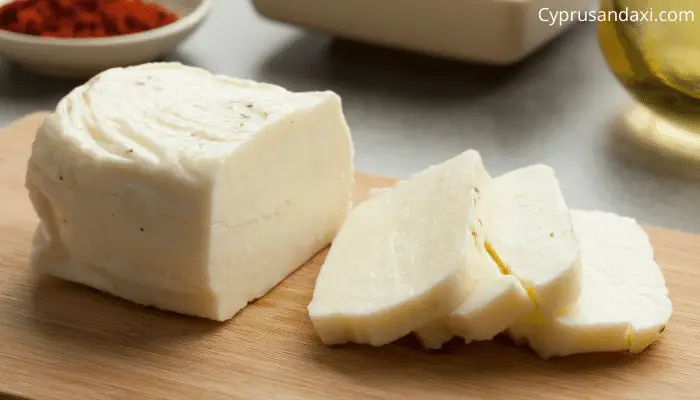
As you can see in the image, Halloumi is white in color with a creamy texture. It is salty in taste.
When the cheese is raw, it has an elastic feel, but it’s cooked, it becomes soft and gentle.
It is stored in its natural juices. The majority of the Halloumi manufacturers beautify it with mint.
Halloumi gives a better and fresher flavor when it is wrapped in mint leaves.
Manufactures also sprinkle fragments of mint leaves on the cheese’s surface to give it a distinctive look.
You can look at that in the image below.

What kinds of Milk is used to make Halloumi?
As we now know that Halloumi is made from milk. They are made not only from a single type of milk but from multiples ones. We will discuss some of them in this section of the article.
Pasteurized Milk and Non-Pasteurised Milk
Basically, the heated milk is the pasteurized milk, and the raw milk is non-pasteurized milk.
Traditionally, non-pasteurized milk was used to make the Halloumi, but in the present days, pasteurized milk is being used.
Pasteurized milk is safer and healthy to drink, and any products created from it will also have health benefits.
Homogenized and Non-Homogenized Milk
The purpose of homogenization is to break down fat molecules in milk so that they resist separation. Without homogenization, fat molecules in milk will rise to the top and form a layer of cream.
Homogenizing milk prevents this separation from occurring by breaking the molecules down to such a small size that they remain suspended evenly throughout the milk instead of rising to the top.
Non-Homogenized milk has a yellow layer of cream at the top.
The milk bottle we find in the supermarket is homogenized milk.
Homogenized milk is fine to make Halloumi, but the majority of the people use non-homogenized milk because it helps in the curd formation.
Why is Rennet used to make Halloumi?
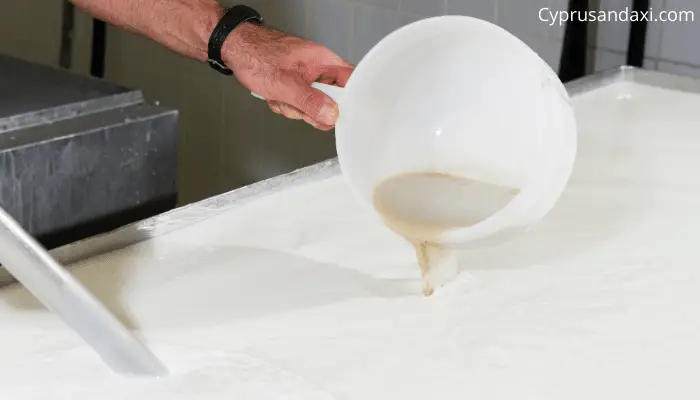
Making Halloumi cheese involves many steps, but essentially it is simply the process of turning a liquid into a solid. Rennet plays an important role in making this happen.
Rennet is the ingredient in cheese-making that makes the milk turn in curd by means of a natural chemical reaction.
There are two kinds of Rennet, traditional and vegetarian.
Traditional rennet comes from the stomach of animals like cows and goats. Vegetarian rennet is mostly found in papaya and pineapple.
Halloumi can be prepared from both kinds of rennet.
How do people eat Halloumi?
People use Halloumi in all sorts of foods.
During the cold season, Halloumi is eaten for breakfast with watermelon alongside bread, olive, and lemons.

People also use Halloumi in sandwiches, bread rolls, barbequed dishes, fried eggs, fried chicken, all kinds of meat, pasta, pie, burger, and much more stuff.

Is Halloumi healthy?
Halloumi is a good source of several important nutrients, including protein and calcium. Its exact content of fat and calories varies depending on how you choose to prepare it.
Halloumi is a great source of protein.
Like other dairy products, halloumi is high in calcium, a micronutrient that is important when it comes to bone health.
What are the potential downsides of eating Halloumi?
Halloumi is relatively high in sodium. It is salty in taste. If you shouldn’t eat more salt, then you shouldn’t eat more Halloumi.
Additionally, while raw halloumi contains a moderate number of calories, it’s often consumed fried or coated in oil. This can significantly increase the calorie content of the final product, potentially contributing to weight gain.
Vegetarians should also check the ingredient label carefully, as some varieties are produced using animal-derived rennet.
Can you eat Halloumi raw?
Halloumi can be eaten raw but is truly delicious cooked. It has a high melting point, making it excellent for grilling or frying.
Can you eat Halloumi when pregnant?
As long as it’s made from pasteurized milk, halloumi is safe to eat during pregnancy. Halloumi is high in Calcium, which will help a pregnant woman to keep their bone health.
Does Halloumi have Lactose?
No, halloumi isn’t lactose-free, but if it is made from sheep or goat milk, it will have a lower lactose level.
How long does Halloumi cheese last?
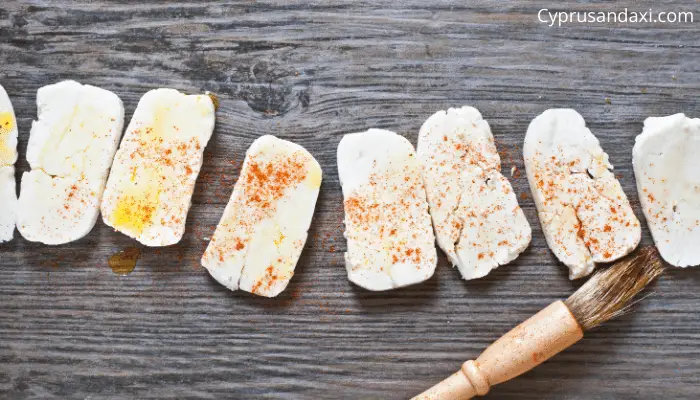
If you wrap the cheese in cheese paper before placing it in an airtight container, you can store the halloumi in the fridge for up to two weeks.
Also, to make sure cheese lasts long, you have to wear latex or plastic gloves each time you handle the cheese. This prevents cross-contamination with the oils and natural bacteria found on your hands.
How to reduce salt in Halloumi cheese?
People use different methods to reduce salt in Halloumi cheese.
Some of them soak Halloumi in hot water for about an hour so that the salty flavor goes away.
Also, some people soak it in Lemon juice. It leaches out halloumi’s preserving salt and softens the cheese nicely.

Does Cyprus export Halloumi?
Yes, indeed, it does.
Cyprus’ famous Halloumi cheese is the most internationally renowned of the island’s exports.
Only in 2018, Cyprus exported 29,000 tons of halloumi all over the world.
The name ‘Halloumi’ is now registered in the European Union as a Community Collective Trade Mark, meaning that no other product can be marketed within EU borders under this name.
It is also registered as a Certification Trade Mark in the UK, US, and Jordan, and will soon be registered in other Middle Eastern countries too.
The government has submitted an application to Brussels to register Halloumi under the EU’s PDO (protected designation of origin) rules. The application is pending approval.
Preparation of Halloumi
Gavin Webber has explained in detail the process of preparing Cypriot Halloumi in one of his videos. I believe this video will be a helpful guide for you to prepare Halloumi at home.
You may also like to read:
Pros & Cons of Living In Cyprus
Is Same-Sex Marriage Legal In Cyprus?
What Languages Are Spoken In Cyprus?
